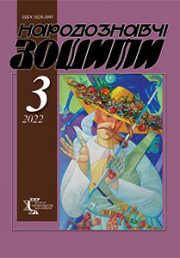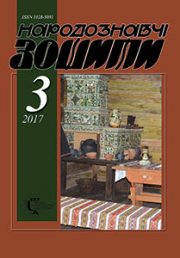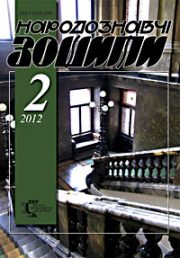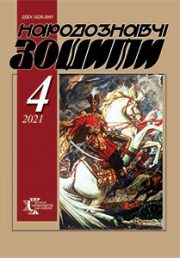The Ethnology Notebooks. 2023. № 6 (174), 1365—1373
UDK 378.096.091:745/749.012
DOI https://doi.org/10.15407/nz2023.06.1365
INDUSTRY PRINCIPLES OF THE DEVELOPMENT OF ART AND INDUSTRIAL EDUCATION: ARTS AND DESIGN
DYACHENKO Alla
- ORCID ID: http://orcid.org/0000-0003-4496-5931
- Candidate of Pedagogical Sciences,
- Associate Professor of the Department of Industrial Design
- and Computer Technologies, Dean of the Faculty of
- Decorative and Applied Arts, member of the Union of designers of Ukraine,
- Kyiv State Institute of Decorative Art And Design Named by M. Boychuk,
- 32, M. Boichuka (Kikvidze) St., 01014, Kyiv, Ukraine,
- Contacts: e-mail: alla.diachenko0107@gmail.com
Abstract. The purpose of the study is theoretical substantiation and confirmation of the effectiveness of the creation of branch principles of artistic and industrial education in the context of studying artistic crafts and design.
The relevance of the research is determined by the need to determine the main trends in the development of the field of artistic crafts and design, as well as to identify the needs and challenges that arise before educators and teachers. As a result of the study, a model of an organizational and methodological approach to the development of creative abilities of students in the field of artistic and industrial education during the study of artistic crafts and design was developed and theoretically confirmed.
The process of developing creative ability includes three main stages: preparatory, design-technological, and artistic-realization. The organic relationship and mutual influence of the components of the organizational-methodical model of education will ensure the effective development of the creative ability of students of artistic and industrial education.
The application of the set of proposed methods depends on the fulfillment of certain pedagogical conditions: creating an atmosphere of interest in creative work with materials; modeling the situation with the possibility of choosing artistic and applied methods of productive activity; creating the effect of suddenness, heuristics and novelty, relevance, approaching the achievements of modern culture, artistic and industrial art; ensuring the unity of all types of educational and creative activities of the applicants in the process of learning in classes on artistic crafts and design and in classes of the disciplines of the artistic block as a whole.
The main sectoral principles that shape the modern development of artistic and industrial education, which had not previously been thoroughly covered in scientific literature, were identified and systematized. A new approach to the integration of design in the context of artistic and industrial education is proposed, which allows to more deeply reveal the potential of students and meet the current market requirements. New teaching methods and techniques have been introduced, which contribute to the development of creativity, critical thinking and professional competences of students in the field of arts and crafts.
Keywords: artistic and industrial education, subject-art image, natural materials, decorative art, methodical model.
Received 30.10.2023
REFERENCES
- Nikolaienko, S. (2007). Innovative development of vocational education in Ukraine. Kyiv: Kniga [in Ukrainian].
- Masol, L., Bazelyuk, O., Komarovska, O., Muromets, V. & Ragozina, V. (2012). Art education in Ukraine: development of creative potential in the 21st century. Analytical report. Kyiv: Aura Books [in Ukrainian].
- Hrytsenko, L., Nehai, H. & Strashko, L. (2021). Implementation of the methodological principle of systematic training in the process of graphic training of specialists in technology and design. Youth & market, 1 (187), 84—91 [in Ukrainian].
- Babii, N. (2020). Current cultural and artistic practices and processes: issues of scientific discourse. Issues of cultural studies, 36, 69—78 [in Ukrainian].
- Halchenko, M., Borinshtein, Ye., Ivanova, N. & Ilina, H. (2021). Visual metaphors in digital lighting spase. Information technologies and teaching aids, 1, 1—14 [in Ukrainian].
- Prusak, V. (2017). Formation and development of design education in Ukraine (late 20th — early 21st centuries). Bulletin of the Lviv National Academy of Arts, 31, 71—82 [in Ukrainian].
- Skynnyk-Myska, D. (2022). Current art practices at the Academy of Arts. Retrieved from: https://zbruc.eu/node/78726 (Last accessed: 15.07.2023).
- Kremen, V. (2020). Modern education: both world and vision. Native school, 2—4, 3—5 [in Ukrainian].
- Ostenda, A., Nestorenko, T. & Zhihir, A. (2018). What do students think of the education curriculum? Case of Katowice School of Technology. International Relations 2018: Current issues of world economy and politics. Conference proceedings, 19th International Scientific Conference, Smolenice Castle (Pp. 582—589). Retrieved from: https://cutt.ly/9Yg6CcI (Last accessed: 15.07.2023).
- Havrylyshina, N. (2022). Decorative and applied art of Ukraine. Great Ukrainian encyclopedia. Retrieved from: https://vue.gov.ua/Decorative and applied art of Ukraine (Last accessed: 15.07.2023).
- Synyshyn, L. (2016). Influence of the state educational policy on the development of artistic and industrial education in Galicia (second half of the XIX — the beginning of the twentieth century). Young scientist, 11 (38), 501—506 [in Ukrainian].
- Shmahalo, R. (2005). Artistic education in Ukraine in the mid XIX — mid XX century: Structuring, methodology, artistic positions. Lviv: Ukrainski Tekhnolohii [in Ukrainian].
- Stankevych, M. (2002). Ukrainian artistic tree of the 16th—20th centuries. Lviv [in Ukrainian].
- Desiatov, T. (2002). Modern scientific vision of continuing vocational education: development strategy on the scale of geopolitical regions. Continuous professional education: theory and practice, 2, 9—23 [in Ukrainian].
- Bereziuk, O., & Dubaseniuk, O. (Ed.). (2009). Methods of step-by-step management of the process of modeling pedagogical situations. In O. Dubaseniuk. Professional pedagogical education: innovative technologies and methods. Zhytomyr: State University named after I. Franka [in Ukrainian]. DOI 10.31494/2412-9208-2018-1-1







